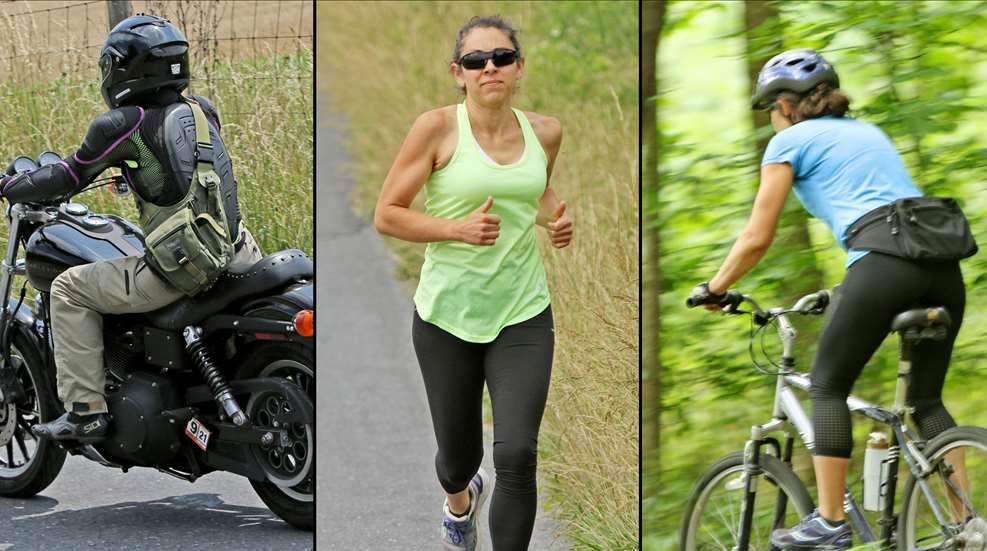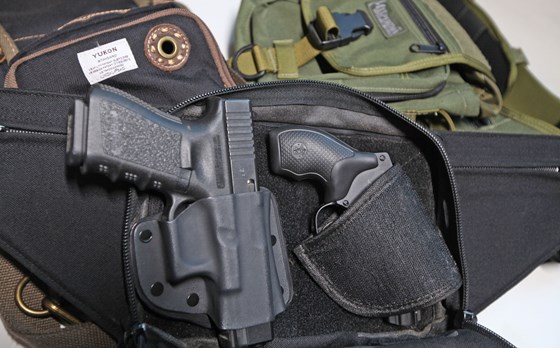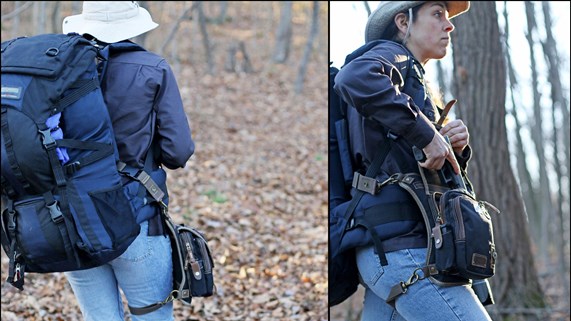
You’re working late at the office after everyone else has gone home for the day, or you’re driving out-of-state on unfamiliar roads by yourself. For most women who carry concealed, these scenarios seem like obvious times when they should have their firearm. But there are other circumstances that we find ourselves in more frequently where we are equally vulnerable, yet choose to go unarmed because it’s inconvenient. Many of these scenarios involve being physically active, including working and playing in the outdoors.
Why is it important to take the necessary steps to carry while hiking the trail, taking a jog or tending to the flowerbeds? Whether running during daylight hours through city parks, biking down a country road or taking a solo trail hike, women have fallen victim to violent crime while participating in these activities alone. I don’t want to imply that these incidents happen with frequency, but solo women are targeted more frequently than solo men or women who are out with a companion of either sex. According to a recent Runner's World survey, 84 percent of women have experienced some kind of harassment or assault while running, injecting fear and anxiety into activities that are supposed to help relieve stress and promote good health.
On first thought, carrying while active seems like a no-brainer. Aren’t you always “active” when you carry? However, activities like running, biking, hiking and yard work present their own carry challenges, namely you need to keep your firearm protected from the elements (including your own sweat) and your style of carry must be comfortable, yet accessible, for a range of motions. While many forms of open carry work great in these scenarios, we’re focusing on concealed carry as many circumstances require it. Here are some suggestions for carrying during those outdoor excursions, going from the lowest to the highest impact.

Yard work, Mowing and Gardening
You’ve probably heard the oft-repeated platitude that you’re most likely to have a car accident within five miles of your home. The reason is simple. That’s where you are driving most often. The same idea applies to self-defense in and around your home. If you’re working outside your home and you need your firearm, having it sitting on the counter inside the house is too far away.
You should thoroughly clean your concealed-carry firearm on a regular basis, even when you haven’t fired it, because regular carry builds up a layer of lint and grime on your firearm. But carrying while doing yard work adds the extra elements of exposing your firearm to dirt, dust and sweat. Yard work also throws in the additional requirement that your carry method be comfortable over an extended period of time and range of motion. This is when you realize that appendix carry or ankle holster you normally favor just doesn’t cut it when you’re pushing a lawnmower.

This ex-police service revolver shows pitting from being carried close to the body in a shoulder holster rig.
Enter the beloved fanny pack, or “waist pack” if you prefer. This little pack can become your best friend, and don’t be ashamed to rock a fanny pack. As with most fashion trends, fanny packs are making a comeback.
Many concealed-carry discussions will devolve into the advantages and disadvantages of “on body” (holsters) and “off body” (purses and backpacks) carry. I don’t consider a fanny pack to be “off body carry” because, unlike a purse or backpack, you’re not likely to take your fanny pack off, lay it down and walk away from it.

If you choose a fanny pack, use one purpose-built for concealed carry. Fanny packs with wider and adjustable waist belts are more comfortable than ones with small waist straps and the wider belt helps them to stay in place as you work. Blackhawk makes a nylon fanny pack that has a zippered firearm pocket where a universal holster is secured to a hook-and-loop patch.
Though, I replaced the universal holster with a firearm-specific molded Kydex holster with a hook-and-loop backing. Two choices for hook-and-loop-backed molded holsters are Crossbreed, which makes an A.R.M.S. line of holsters for a handful of guns, and Alien Gear, who makes this style for almost every type of handgun. Fellow NRA Women contributor Becky Yackley modified a Tactica Defense fanny pack to fit a Kydex holster that attaches inside with a hook-and-loop patch to take hiking and biking.

Walking and Hiking
Walking is a common form of exercise and recreation for many people. For walking, the belt holster you already use may work fine. If temperatures permit a cover garment, an outside-the-waistband (OWB) holster keeps the firearm off your body. But if your holster set-up is uncomfortable, or you can’t carry OWB … fanny pack.
Hiking takes all the elements of walking and adds in a few degrees of complication—you will be exerting yourself more, traveling over uneven terrain and probably carrying some type of backpack. When hiking with a backpack, waist-mounted holsters are often impractical. Backpack straps and waistbelts can inhibit access to a handgun carried on your belt. Avoid the temptation of dropping your handgun into your hiking pack. You never need to access your ultra-compact camp stove in a hurry. That’s why it finds its way to the bottom of your pack. Your concealed-carry handgun shouldn’t be nestled beside it. Also, what are the chances that you’ll drop your pack as soon as you get to your destination and then find yourself on the other side of your campsite from it when you need your handgun?
Depending on the design of your backpack, you can use a fanny pack to keep your firearm in front of you. Other types of bags can be strapped around your thigh and secured to a belt, offering access by pulling up a flap or a quickly unzipping the firearm pocket. Urban Utility Bags make a couple of different designs that have a hook-and-loop platform inside a pocket where you can attach a variety of Crossbreed’s Kydex holsters, such as this Ukoala bag.

A similar scenario to hiking is fishing. A fanny pack keeps the gun up high, dry, secure and comfortable, while giving your hands the freedom for baiting, casting and unhooking fish.

Biking and Motorcycling
A critical factor with these riding activities is that your firearm has to stay secure, not only through the bumps and the bounces, but in the worst-case scenario of a crash or fall. Your method of carry while doing these activities needs to have a reliable form of active retention. Active retention means you have to press a button or lever to release the gun from the carry system or that it is contained within a zippered pocket.

For biking, a pair of compression biking shorts or leggings with a built-in holster pocket can be a good option. These pockets should have a lining that protects your firearm’s trigger, like a proper holster, and should also have a retaining strap that goes over the grip to ensure the firearm stays in place.
If your biking “uniform” allows you to wear a belt and a baggy concealment garment, an outside-the-waistband paddle holster is a great option. Holsters like the Blackhawk Serpa keep the firearm off your body and also employ an active retention system. If neither a compression garment or waist holster are comfortable for you or work with your style of exercise attire, there’s always the trusty fanny pack.

With motorcycle riding, a sling pack or the leg-mounted bag works well to carry a few more items on your journey, yet still have a dedicated pocket for your firearm. A sling bag can be slung from back to front quickly. I use a Maxpedition Fatboy Versipack to carry a larger pistol. Protective motorcycling pants often don’t work well with a conventional waist mounted holster, but a shoulder holster can keep your handgun out of the way, yet easily accessible under your riding jacket.

Running and Jogging
This high-impact sport is one of the hardest activities to find a comfortable and secure way to conceal carry. While a well-designed carry system can accommodate nearly any size of handgun for the previously discussed activities, with running the size and weight of the gun become a limiting factor. I’ve tried belly band holsters and waist packs, but both end up bouncing up and down, causing me to constantly clutch or adjust the pack or holster during the run.
When running, I found it was most comfortable and functional to carry the handgun against my body, so that it moves with me. Leggings or compression shorts are the best way to carry a compact handgun. It is essential that the holster pockets have a retention strap to keep the handgun from bouncing out of the pocket.
I tried out a pair of concealed carry leggings made by Tactica Defense Fashion. They carried Colt Mustang-type .380s (Kimber Micro, Springfield 911, Sig 238) and compact, alloy-framed revolvers well and would work for other types of handguns that weigh around 15 oz. or less. Many of the leggings or shorts have pockets on either side for right or left-hand draw as well as front pockets for appendix carry. I found the 5 o’clock position to work the best. By wearing a longer or slightly baggier shirt that is untucked, you can keep the firearm completely concealed. Though a minimal design, the leggings also have a smaller pocket to carry your keys and your concealed carry permit.
The downside to running with your firearm against your body is that you will get your gun sweaty. Be sure to wipe down the handgun after exercising with an oiled cloth and as with any firearm that you carry, take time to break it down and give it a more thorough cleaning at least once a week.
If it’s important to you to carry concealed, then it’s important to carry even when you’re doing physical activity. You shouldn’t avoid being active because you don’t feel safe and you shouldn’t feel unsafe because you don’t think you can carry comfortably, securely or concealed. With a little experimenting to find the system that works for you, carrying while active in the outdoors can be a seamless part of your everyday carry.















































